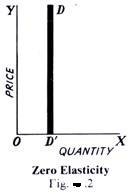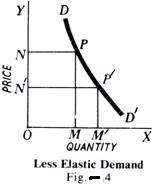Demand extends or contracts respectively with a fall or rise in price. This quality of demand by virtue of which it changes (increases or decreases) when price changes (decreases or increases) is called Elasticity of Demand.
“The elasticity (or responsiveness) of demand in a market is great or small according as the amount demanded increases much or little for a given fall in price, and diminishes much or little for a given rise in price”. – Dr. Marshall.
Elasticity means sensitiveness or responsiveness of demand to the change in price.
This change, sensitiveness or responsiveness, may be small or great. Take the case of salt. Even a big fall in its price may not induce an appreciable ex appreciable extension in its demand. On the other hand, a slight fall in the price of oranges may cause a considerable extension in their demand. That is why we say that the demand in the former case is ‘inelastic’ and in the latter case it is ‘elastic’.
The demand is elastic when with a small change in price there is a great change in demand; it is inelastic or less elastic when even a big change in price induces only a slight change in demand. In the words of Dr. Marshall, “The elasticity (or responsiveness) of demand in a market is great or small according as the amount demanded increases much or little for a given fall in price, and diminishes much or little for a given rise in price.” But the demand cannot be perfectly ‘elastic’ or ‘inelastic’.
Completely elastic demand will mean that a slight fall (or rise) in the price of the commodity concerned induces an infinite extension (or contraction) in its demand. Completely inelastic demand will mean that any amount of fall (or rise) in the price of the commodity would not induce any extension (or contraction) in its demand. Both these conditions are unrealistic. That is why we say that elasticity of demand may be ‘more or less’, but it is seldom perfectly elastic or absolutely inelastic.
Types of Elasticity
Distinction may be made between Price Elasticity, Income Elasticity and Cross Elasticity. Price Elasticity is the responsiveness of demand to change in price; income elasticity means a change in demand in response to a change in the consumer’s income; and cross elasticity means a change in the demand for a commodity owing to change in the price of another commodity.
(a) Infinite or Perfect Elasticity of Demand
Let as first take one extreme case of elasticity of demand, viz., when it is infinite or perfect. Elasticity of demand is infinity when even a negligible fall in the price of the commodity leads to an infinite extension in the demand for it. In Fig. 1 the horizontal straight line DD’ shows infinite elasticity of demand. Even when the price remains the same, the demand goes on changing.

(b) Perfectly Inelastic Demand
The other extreme limit is when demand is perfectly inelastic. It means that howsoever great the rise or fall in the price of the commodity in question, its demand remains absolutely unchanged. In Fig. 2, the vertical line DD’ shows a perfectly inelastic demand. In other words, in this case elasticity of demand is zero. No amount of change in price induces a change in demand.

In the real world, there is no commodity the demand for which may be absolutely inelastic, i.e., changes in its price will fail to bring about any change at all in the demand for it. Some extension/contraction is bound to occur that is why economists say that elasticity of demand is a matter of degree only. In the same manner, there are few commodities in whose case the demand is perfectly elastic. Thus, in real life, the elasticity of demand of most goods and services lies between the two limits given above, viz., infinity and zero. Some have highly elastic demand while others have less elastic demand.
(c) Very Elastic Demand
Demand is said to be very elastic when even a small change in the price of a commodity leads to a considerable extension/contraction of the amount demanded of it. In Fig. 3, DD’ curve illustrates such a demand. As a result of change of T in the price, the quantity demanded extends/contracts by MM’, which clearly is comparatively a large change in demand.

(d) Less Elastic Demand
When even a substantial change in price brings only a small extension/contraction in demand, it is said to be less elastic. In Fig. 4, DD’ shows less elastic demand. A fall of NN’ in price extends demand by MM’ only, which is very small.

Significance of Elasticity of Demand
- Determination of Output Level
For making production profitable, it is essential that the quantity of goods and services should be produced corresponding to the demand for that product. Since the changes in demand are due to the change in price, the knowledge of elasticity of demand is necessary for determining the output level.
- Determination of Price
The elasticity of demand for a product is the basis of its price determination. The ratio in which the demand for a product will fall with the rise in its price and vice versa can be known with the knowledge of elasticity of demand.
If the demand for a product is inelastic, the producer can charge high price for it, whereas for an elastic demand product he will charge low price. Thus, the knowledge of elasticity of demand is essential for management in order to earn maximum profit.
- Price Discrimination by Monopolist
Under monopoly discrimination the problem of pricing the same commodity in two different markets also depends on the elasticity of demand in each market. In the market with elastic demand for his commodity, the discriminating monopolist fixes a low price and in the market with less elastic demand, he charges a high price.
- Price Determination of Factors of Production
The concept of elasticity for demand is of great importance for determining prices of various factors of production. Factors of production are paid according to their elasticity of demand. In other words, if the demand of a factor is inelastic, its price will be high and if it is elastic, its price will be low.
- Demand Forecasting
The elasticity of demand is the basis of demand forecasting. The knowledge of income elasticity is essential for demand forecasting of producible goods in future. Long- term production planning and management depend more on the income elasticity because management can know the effect of changing income levels on the demand for his product.
- Dumping
A firm enters foreign markets for dumping his product on the basis of elasticity of demand to face foreign competition.
- Determination of Prices of Joint Products
The concept of the elasticity of demand is of much use in the pricing of joint products, like wool and mutton, wheat and straw, cotton and cotton seeds, etc. In such cases, separate cost of production of each product is not known.
Therefore, the price of each is fixed on the basis of its elasticity of demand. That is why products like wool, wheat and cotton having an inelastic demand are priced very high as compared to their byproducts like mutton, straw and cotton seeds which have an elastic demand.
- Determination of Government Policies
The knowledge of elasticity of demand is also helpful for the government in determining its policies. Before imposing statutory price control on a product, the government must consider the elasticity of demand for that product.
The government decision to declare public utilities those industries whose products have inelastic demand and are in danger of being controlled by monopolist interests depends upon the elasticity of demand for their products.
- Helpful in Adopting the Policy of Protection
The government considers the elasticity of demand of the products of those industries which apply for the grant of a subsidy or protection. Subsidy or protection is given to only those industries whose products have an elastic demand. As a consequence, they are unable to face foreign competition unless their prices are lowered through subsidy or by raising the prices of imported goods by imposing heavy duties on them.
- Determination of Gains from International Trade
The gains from international trade depend, among others, on the elasticity of demand. A country will gain from international trade if it exports goods with less elasticity of demand and import those goods for which its demand is elastic.
In the first case, it will be in a position to charge a high price for its products and in the latter case it will be paying less for the goods obtained from the other country. Thus, it gains both ways and shall be able to increase the volume of its exports and imports.